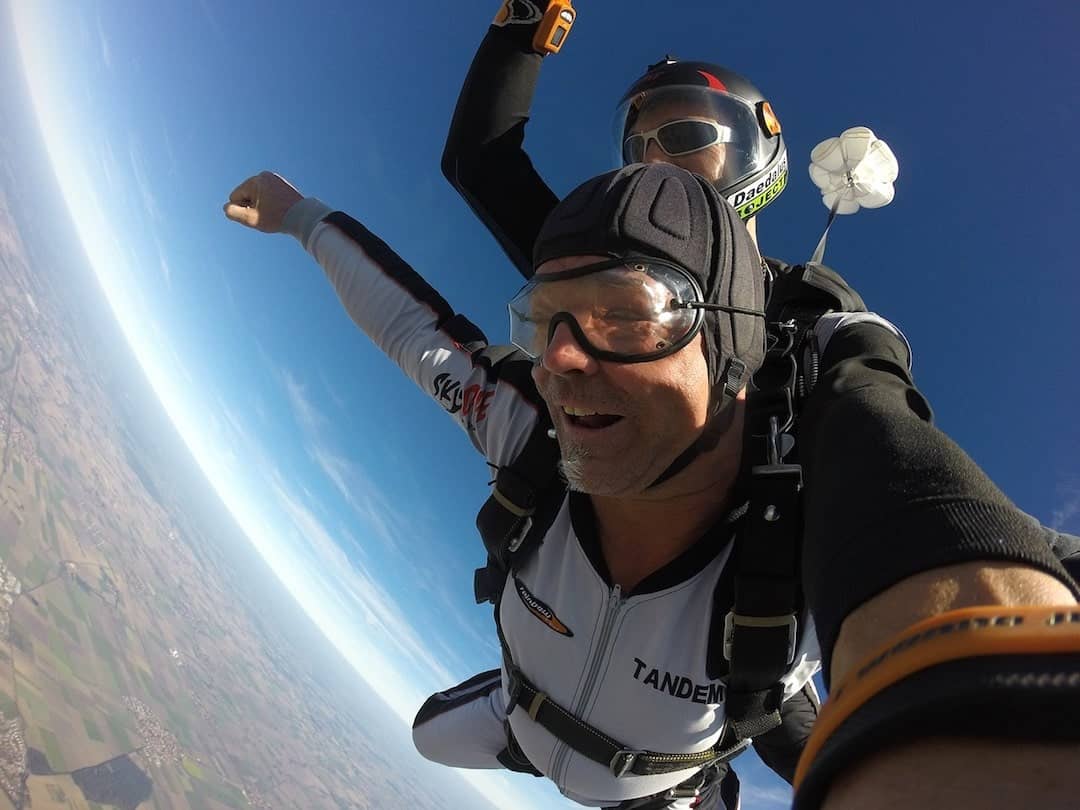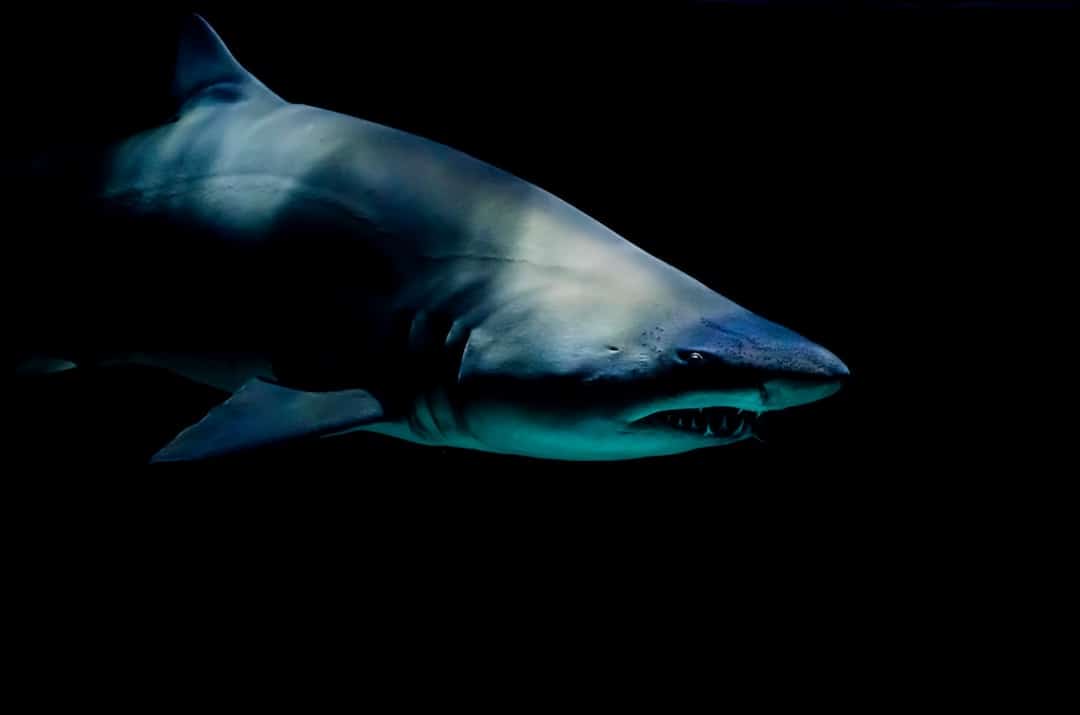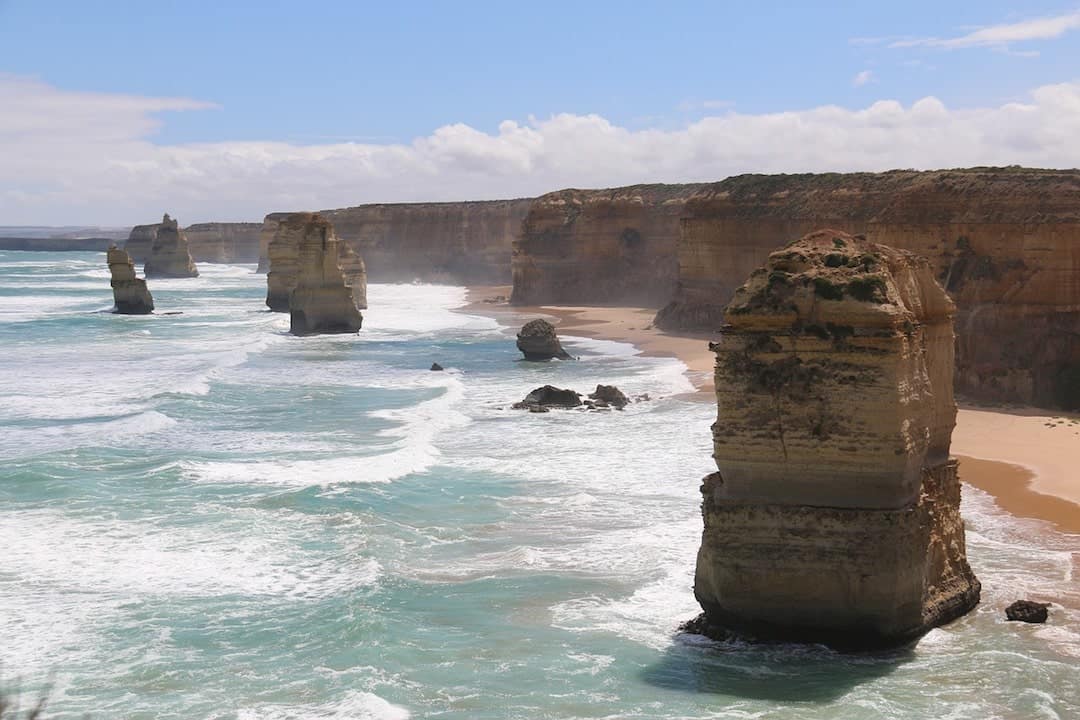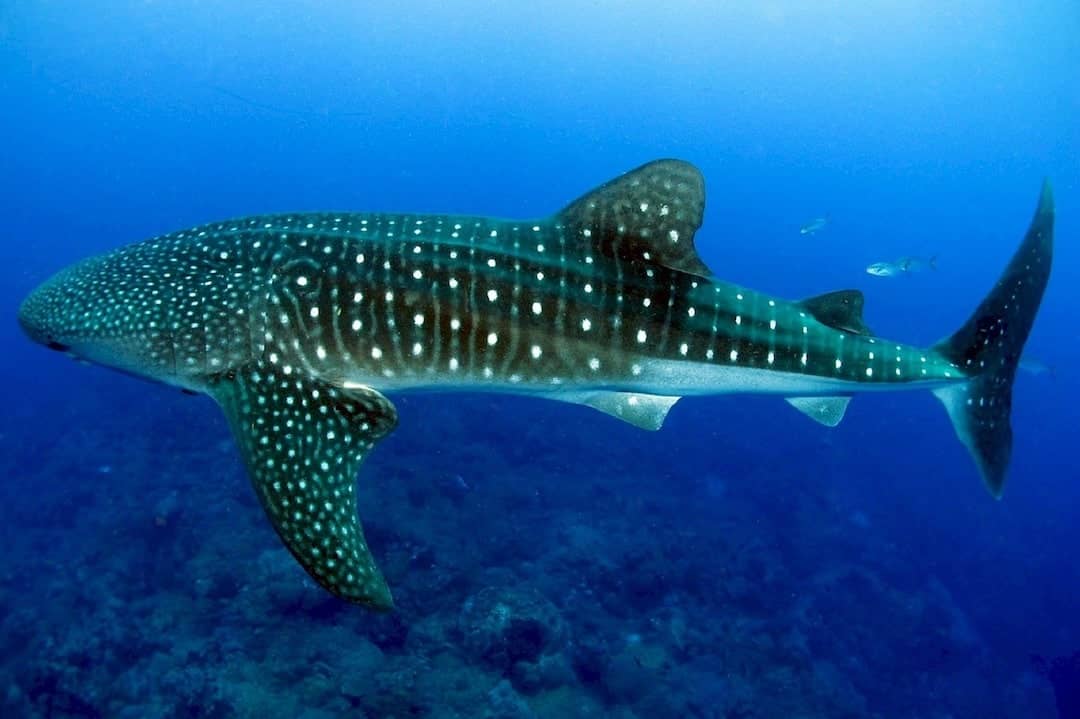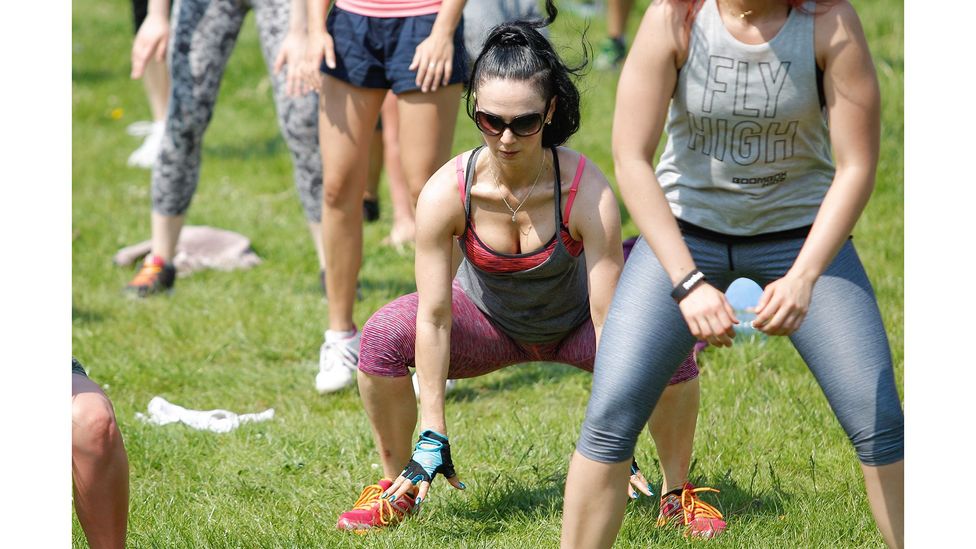1. CLOUD GAZING
Watching the clouds pass is an easy way to quiet a busy mind. In fact, cloud gazing is technically an informal form of meditation. You sit idly and focus on nothing but the sky. As clouds drift, you can imagine each cloud as a problem or difficult situation floating away.
Take a deep breath and focus on that cloud as you watch it pass through your line of sight and disappear in the distance. You can also channel your inner child by looking for fun shapes in the clouds.
Cloud gazing is a quick and peaceful way to calm your nervous system—even if it’s just a few minutes of sitting on a park bench, looking out the window, or walking during your lunch break with your eyes on the horizon.
2. FULL-BODY SCAN
Stress and anxiety can often be viscerally felt in your body. For example, a throbbing headache in your temples or a tightness in your lower back can be physical manifestations of mental blockages. This mindfulness exercise helps you tune into those sensations without feeling judgment or the instant need to “fix” the problem. Instead, it centers you on the moment by cultivating awareness and relaxation.
Whether at your desk or on a yoga mat, you can do a full-body scan just about anywhere. You can visualize a scanner moving from head to toe and registering your physical or emotional experiences without judgment. Give it a try with this five-minute body scan meditation:
3. VIRTUAL REALITY MEDITATION
With its enchanting visuals and video-game-like experience, virtual reality uses a VR headset with visuals, binaural beat audio, breathing exercises, and other mindfulness guides. One VR mindfulness app is called TRIPP, and it may completely change the way you look at meditation. Called one of the “Best Inventions of 2022” by Time Magazine, TRIPP is a sort of “mindful metaverse” that guides you through visualizations and mesmerizing world landscapes without leaving the comfort of your home.
With its affordable plans and easy mobile app, this next-level approach to mindful meditation is accessible to kids, teens, and adults. Check out the TRIPP website or the Oculus VR meditation for more.
4. A COLD PLUNGE OR COLD SHOWER
Cryotherapy or cold plunging may sound like your worst nightmare. Who is crazy enough to shock their body with frigid water and extreme discomfort? Apparently, someone who is craving a drastic mindset shift! The short and intense temperature swing can catapult you out of your thoughts so that you can feel calmer and more present.
Cold therapy has exploded in popularity, with many celebrities like Jack Dorsey, Lady Gaga, and Joe Rogan jumping on the freezing bandwagon. Wim Hof, also known as The Iceman, is an extreme athlete and social media icon who has brought cold plunges to the forefront. This modern trend with ancient roots has profound benefits for both mental and physical health. Research shows that cold plunges and showers can:
Produce mood-boosting endorphins
Improve focus
Significantly reduce depressive symptoms
Improve the quality of sleep
Provide stress relief
Speed up muscle recovery after exercise
A cold therapy session is as simple as turning your shower to the cold water and standing under it for 1 to 5 minutes. You can also use cold water immersion by making an ice bath or jumping into frigid water. For a more controlled experience, try going to a cryotherapy studio like iCryo or learn more about the DIY Wim Hof Method to get your cold plunge on at home.
5. SAUNA OR HEAT THERAPY
If exposing your skin to super cold water sounds like too much, you can always go in the opposite direction with heat therapy. Head to your local gym or spa for a sauna session for a mindful sweat. High temperatures activate your cardiovascular system and increase the blood supply to your brain.
Sauna bathing has been practiced in Finland for thousands of years. Scientists have found that sauna bathing reduces the risk of cardiovascular disease as well as neurocognitive disease. It can help alleviate symptoms of arthritis, headaches, and the flu.
Sitting in a sauna or steam room also makes it easier to focus on your breath without any distractions. As your muscles relax, your mind stops thinking about the body so you can close your eyes and let your thoughts wander blissfully.
6. INVERSION THERAPY
When you go upside down, you literally change your perspective so you can return to the right-side-up world with a new viewpoint of your reality. This mindfulness activity is proven to calm your nervous system and help you feel more peaceful. Inversions also improve your breathing, core strength, focus, and posture.
Don’t worry, you don’t have to do a full-on handstand to enjoy those benefits! Whether you want to go fully upside down or enjoy a mild inversion with your feet still planted on the floor, there is an abundance of ways to reap the benefits of inversion therapy:
Downward Dog or Child’s Pose in yoga (Pro Tip: Try a quick 2-minute Downward Dog in between afternoon meetings for an energy boost)
An inversion chair or table
A headstand bench or yoga stool
Hanging upside down in a forward fold (Pro Tip: Add a forward fold into your daily rituals, for example, you can reach for your toes for a few moments after you finish your morning coffee)
Wall-supported handstand
Laying on your couch with your head hanging off
Just remember to consult your doctor before practicing an inversion and take all safety precautions to ensure that you don’t injure your spine or neck.
7. AROMATHERAPY PRACTICE
Herbal scents like chamomile and lavender are proven to relax the nervous system and reduce anxiety. Aromatherapy scents activate a part of our brain’s limbic system, which controls memory, emotion, and learning.
Try placing an essential oil diffuser in the corner of your office and filling it with diluted soothing scents. You can also opt for candles, incense, or an essential oil roller perfume to enjoy the benefits of aromatherapy on the go. You can combine aromatherapy with any other mindfulness practice to enhance your focus and relaxation.
Pro Tip: Have you noticed how specific smells can activate poignant memories and send you back in time? You can use this scent association to help get your mind into “work mode” or “meditation mode” by creating a repeated ritual. For example, rosemary is known to help with memory, so it can be helpful to smell the scent of rosemary every time you sit down to study for an exam or work presentation. Find a scent you like and reserve it specifically for your productivity or mindfulness rituals.
8. EFT TAPPING
The Emotional Freedom Technique (EFT) is based on principles of acupuncture and Traditional Chinese Medicine. Rather than using needles, you use your fingertip to tap with slight pressure on an area of your face. Advocates say that EFT tapping helps you access energy pathways or meridians to restore your body’s energy balance. Research shows that this mindfulness activity has the added benefits of reducing anxiety, improving academic performance, lowering heart rate, and reducing cortisol (your stress hormone).
This simple EFT tapping exercise can be done anytime you need a silent stress reliever:
Close your eyes and tune into your deep breathing.
Identify a specific problem you are facing. For example, you may be having a hard time staying focused, or you may feel stressed out.
Insert your problem into this statement and repeat it to yourself internally: “Even though I feel [stressed/sad/overwhelmed/unfocused], I deeply and completely accept myself as I am.”
Then, focus on this positive affirmation and begin the tapping sequence. This exercise will focus on your eyebrow (EB) meridian point, but there are several other EFT tapping points you can tap as well.
Bring your middle and forefinger together.
Lightly tap the center of your forehead, with one finger on each side of the bridge of the nose right where the brow bones begin.
Close your eyes and breathe deeply as you tap for 3-5 minutes.
You can learn a full EFT tapping technique in this video interview with Marie Forleo and Nick Ortner:
9. FINGER TAPPING
If you cannot sit still during a lecture or virtual meeting, finger tapping is a form of mindful movement that grounds you in the present moment. Unlike tapping your nails on the desk or fidgeting with a pen, this exercise is so lowkey that no one will know you’re doing it.
As you listen to a presentation or wait for your turn to speak on a Zoom call, bring your hands into your lap. Next, tap your fingers one-by-one:
Begin by touching your index finger to your thumb while taking a deep breath.
On the next inhale, touch your middle finger to your thumb and then exhale.
Follow up the next breath with your ring finger to your thumb.
Lastly, tap your pinky to your thumb and take a deep breath.
Then, move backwards to repeat the cycle: pinky, ring, middle, then index finger.
Repeat each finger tap as many times as needed.
10. MINDFUL EATING
You have to eat every day, so why not incorporate a quick mindfulness exercise into your lunch break? Instead of rushing to chow down your lunch in between, mindful eating helps you pause and enjoy your meals. Because it involves slower chewing and mental relaxation, mindful eating can improve digestion and reduce bloating.
Practice mindful with these easy hacks:
Sit down to eat your meals rather than eating on the go. Even if it’s just 10 minutes, this pause signals the nervous system to enter “rest and digest” mode.
Thoroughly chew every bite before swallowing. Optionally, count your chews. Experts say that most food should be chewed about 30 times.
Focus on the medley of flavors in the food. See if you can identify specific ingredients like pepper or garlic.
Eliminate distractions by putting down your phone and turning off the TV.
Practice gratitude before eating. Remember what a privilege it is to enjoy a wholesome meal.
Eat in silence or while talking with friends and family.
Mindfulness Activities for Kids
Getting hyper kids to sit still and be mindful is no simple task. These exercises can help kids relax without triggering boredom.
11. FIVE SENSES CHECK-IN
Whether part of your morning routine or a midday check-in, sensory awareness is a unique way of bringing children’s attention to the present moment. This exercise makes mindfulness more tangible by tapping into the five senses.
To do it, ask kids to identify:
5 things they can see
4 things they can feel
3 things they can hear
3 things they can smell
1 thing they can taste
12. ANIMAL BONDING
Spending time with cuddly creatures is proven to reduce stress, improve compassion, and help children become more responsible. If your child is feeling overwhelmed by school or you think they need a fun way to unwind in the evenings, try introducing them to an animal.
Mindful animal bonding may look like:
Sitting with a calm dog, cat, or another pet and stroking their fur for 10 minutes.
Playing a game with a pet, such as fetch or a laser toy.
Therapeutic horseback riding.
Gently brushing a furry friend.
Taking kids to volunteer at a local animal shelter.
Of course, cuddling with furry friends isn’t just for kids. Anyone can benefit from bonding with the pets in their life.
13. PAINT BY NUMBER
Let your child drift off into a world of colorful paint strokes and meditative focus. A paint-by-number workbook gives them the structure of an educational or decorative outline while allowing the freedom of creative expression.
This nature-themed paint-by-number set includes small canvases and acrylic paints for a fun and relaxing activity.
14. NATURE WALK WITH “I SPY”
In the age of devices and virtual activities, a daily break in the great outdoors can help kids feel more grounded and relaxed. Find a playground, park, or outdoor space and allow children to enjoy unstructured exploration without any plans. If you are walking through a trail or park, try playing “I Spy” by inviting kids to point out:
Uniquely colored flowers
The shapes of leaves
The textures of different sticks or rocks
Sounds of birds or insects
Shapes of clouds in the sky
Mindfulness Activities for Teens
Many of the activities above can be done as a teenager as well. But here are some more ideas for the modern teenager who is being bombarded with hormonal changes, self-esteem challenges, and endless media influence. Here are some healthy ways to help them chill out and reflect.
15. JOURNAL PROMPTS
During the confusion and inner struggles of adolescence, journaling is proven to help teens with self-reflection and emotional processing.
Have your teen set down their devices and grab a pen and paper. Set a timer for 10 to 15 minutes. Encourage teens to reflect on their current mindset and use their imagination to answer a journal prompt, such as:
Right now, I am feeling…
What things at school make me smile?
What skills or talents come naturally to me?
I would like to improve at…
In what ways do I feel loved right now?
My idea of a perfect day would include…
If I could describe the perfect vacation destination, it would look like…
16. PUZZLES
Puzzles are a perfect mindfulness activity because they require you to focus on fitting pieces together. In the process, the stress and emotion of the outer world can quickly dissolve. Modern teens, in particular, can benefit from the calming effect of puzzles to improve their concentration and focus.
Try substituting 30 minutes of social media scrolling with a puzzle that fits your interests. We love these Hogwarts and Star Wars puzzles.
17. GUIDED MEDITATION
Meditating requires mental discipline and focus that feels unattainable for many people, especially for the scattered mind of a high-energy teen. But guided meditations combine calming music with the voice of a mindfulness exercise to help guide you through a specific mental exercise.
Try this evening guided meditation for teenagers and set the mood with a dim room, cozy pillows, and aromatherapy.
18. SELF-COMPASSION MINDFULNESS EXERCISE
We all mess up at some point or another, but teens are particularly prone to mentally beating themselves up when they make mistakes or have embarrassing moments. Considering that harsh self-criticism is associated with a greater risk for mental illness, it’s vital to teach adolescents how to cut themselves some slack. Self-compassion is the art of accepting oneself completely—flaws and all!
Anyone at any age can benefit from more self-compassion through mindfulness. When you or someone you love is feeling low or repeating harmful self-talk, try this: “How would you treat a friend?” compassion exercise:
What am I struggling with? Identify the trigger for self-criticism. For example, imagine you are going through a bad breakup and struggling with self-esteem (we’ve all been there!)
How am I talking to myself in my head? Take a moment of silence to analyze your thoughts related to this situation. In this example, some people may repeat negative self-talk like “I wasn’t good enough for them” or “I must be too ugly/dumb/embarrassing for them.”
If your friend was in this situation, what would you say? Asking this question can help develop self-compassion by reframing the situation. Nobody would tell their friend, “Of course, he/she rejected you because you are ugly and awkward.” Instead, they would try to coach and uplift them with words like, “Don’t worry, they just weren’t right for you. There is someone out there who will appreciate you for how unique and amazing you are!” Instead of criticizing yourself, talk to yourself as if you are soothing a friend who is going through the same situation.
Try one of these guided audio self-compassion exercises from psychologist Dr. Kristin Neff.
Mindfulness Activities for Adults
19. MINDFUL MUSCLE BUILDING
If you’re the active type who can’t imagine sitting still for meditation, you will be delighted to know that weightlifting can provide many of the same benefits! Many studies show that strength training improves cognition, mental health, self-esteem, and sleep.
So head to the gym and start lifting! You can take your weight practice to the next level with mindful muscle building that uses visualization. You can envision your muscles flexing and extending as you lift a dumbbell in a bicep curl or flex your quads on a squat machine. It helps to learn basic anatomy to visualize your muscle movements better.
20. TEA TIME
The art of preparing tea is a delightful opportunity to slow down and engage with your senses. Some patience is involved, so resist the urge to grab your phone or busy yourself with something else.
“There is something in the nature of tea that leads us into a world of quiet contemplation of life.”
– Lin Yutang
When you’re feeling overwhelmed or need a moment of self-reflection, try this easy 5-minute tea ritual:
While you wait for the water to boil, avoid any distractions. Simply stand there, breathe, and just be.
When the water is hot, pour it over a tea bag or loose-leaf blend. Herbal teas are particularly calming. Try herbs like chamomile, lemon balm, ashwagandha, reishi mushroom, and mint.
As the tea steeps, smell the herbal aromas and inhale the steam.
Sit in stillness while the tea cools and slowly sip by a window or outdoors.
21. YIN YOGA FOR FOCUS
Ancient yoga philosophy says that much of our mental frustrations and blockages can cause physical tension in the hips. Yin yoga is an easygoing, slow type of yoga that focuses on deep stretching, pranayama breathing, and relaxation. It can help you declutter your mind before engaging in a mentally demanding task.
Try this simple yin sequence for deeper focus:





















